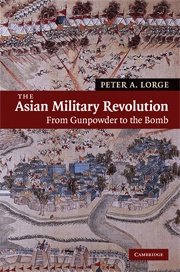Book contents
- Frontmatter
- Contents
- List of maps
- Acknowledgments
- Chronology
- Glossary
- Introduction
- 1 China through the Yuan
- 2 Japan and the wars of unification
- 3 The Chinese military revolution and war in Korea
- 4 Southeast Asia
- 5 South Asia to 1750
- 6 The military revolution in South Asia, 1750–1850
- 7 The arrival and departure of the West
- Conclusion
- Index
- References
2 - Japan and the wars of unification
Published online by Cambridge University Press: 05 June 2012
- Frontmatter
- Contents
- List of maps
- Acknowledgments
- Chronology
- Glossary
- Introduction
- 1 China through the Yuan
- 2 Japan and the wars of unification
- 3 The Chinese military revolution and war in Korea
- 4 Southeast Asia
- 5 South Asia to 1750
- 6 The military revolution in South Asia, 1750–1850
- 7 The arrival and departure of the West
- Conclusion
- Index
- References
Summary
Unlike the other Asian polities discussed in this book, Japan emerged as a modern, militarily powerful nation in the late nineteenth and early twentieth century. It avoided the plague of Western colonialism that so badly disrupted many societies around the world, and handily absorbed the technological developments of the Industrial Revolution. But in most respects Japan's reaction to the introduction of firearms was similar to the rest of Asia. Firearms were revolutionary in Japanese warfare, becoming indispensable weapons for armies soon after the Portuguese introduced them in 1543. They fit extremely well within the already missile-oriented mode of Japanese warfare. The Portuguese arquebus, and the far more widely available Japanese reproductions of it, became prominent at just the time when Oda Nobunaga began to unify Japan. Toyotomi Hideyoshi completed that unification, and the coincidence of the introduction of new military technology and political change seems to imply causality; we shall see that this was not the case, in the same way that Japan's avoidance of the full effects of colonialism was due not to culture, but to geography and economics.
It was political and social development that allowed the arquebus to be taken up and used effectively, not the technology that initiated political and social development. Indeed, both Hideyoshi and the man who truly gained the benefits of Japan's unification, Tokugawa Ieyasu, successfully altered the direction of social development exactly contrary to where the technology seemed to drive it.
- Type
- Chapter
- Information
- The Asian Military RevolutionFrom Gunpowder to the Bomb, pp. 45 - 65Publisher: Cambridge University PressPrint publication year: 2008

